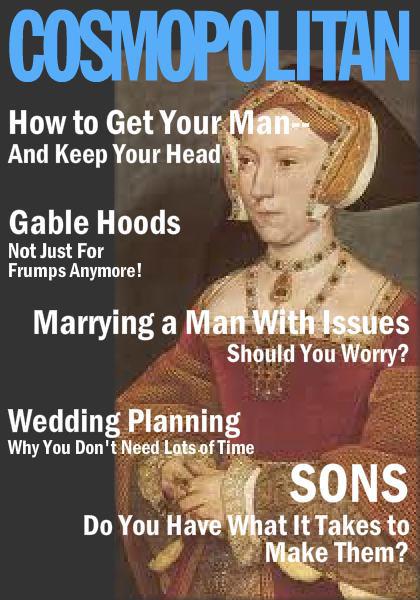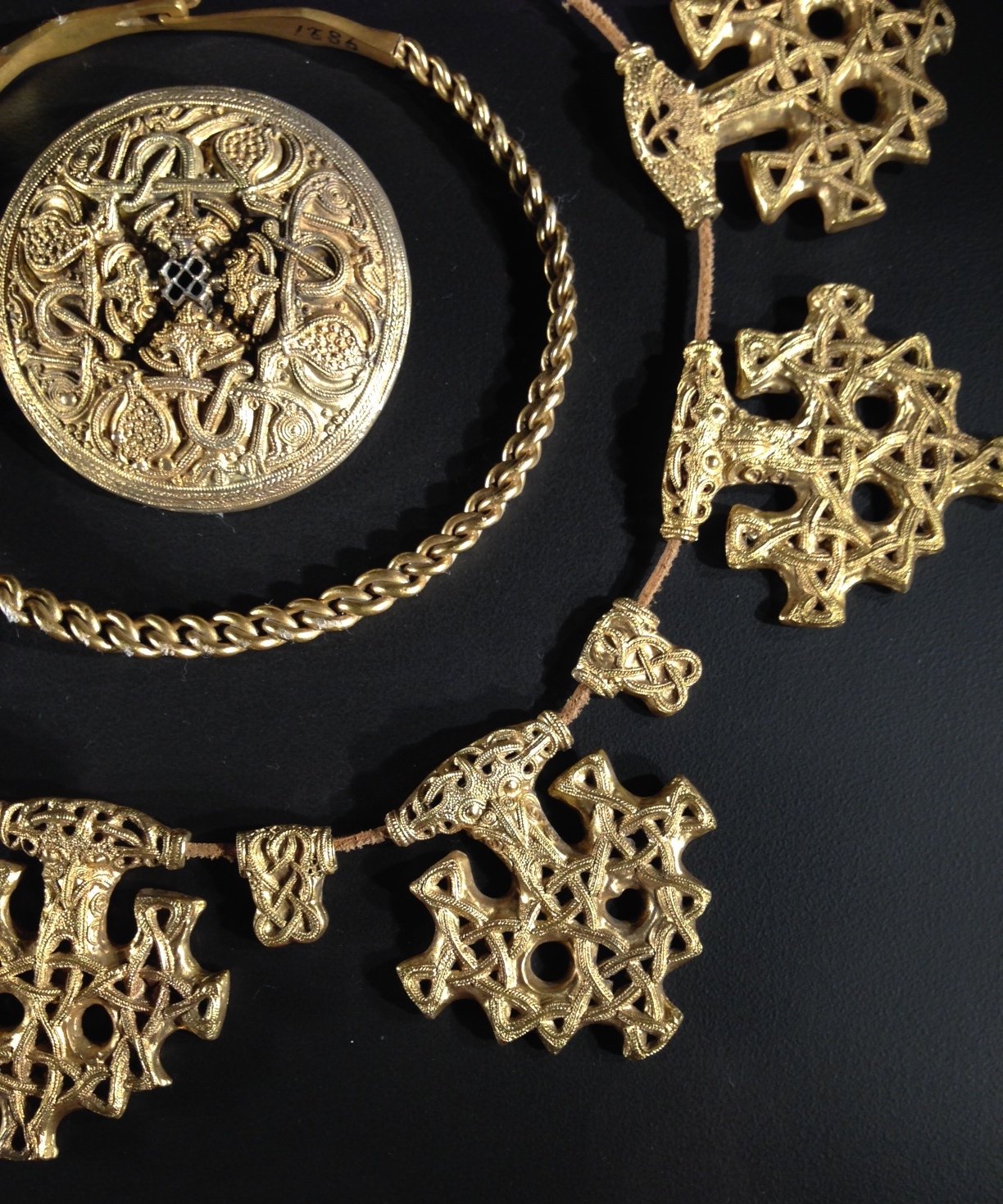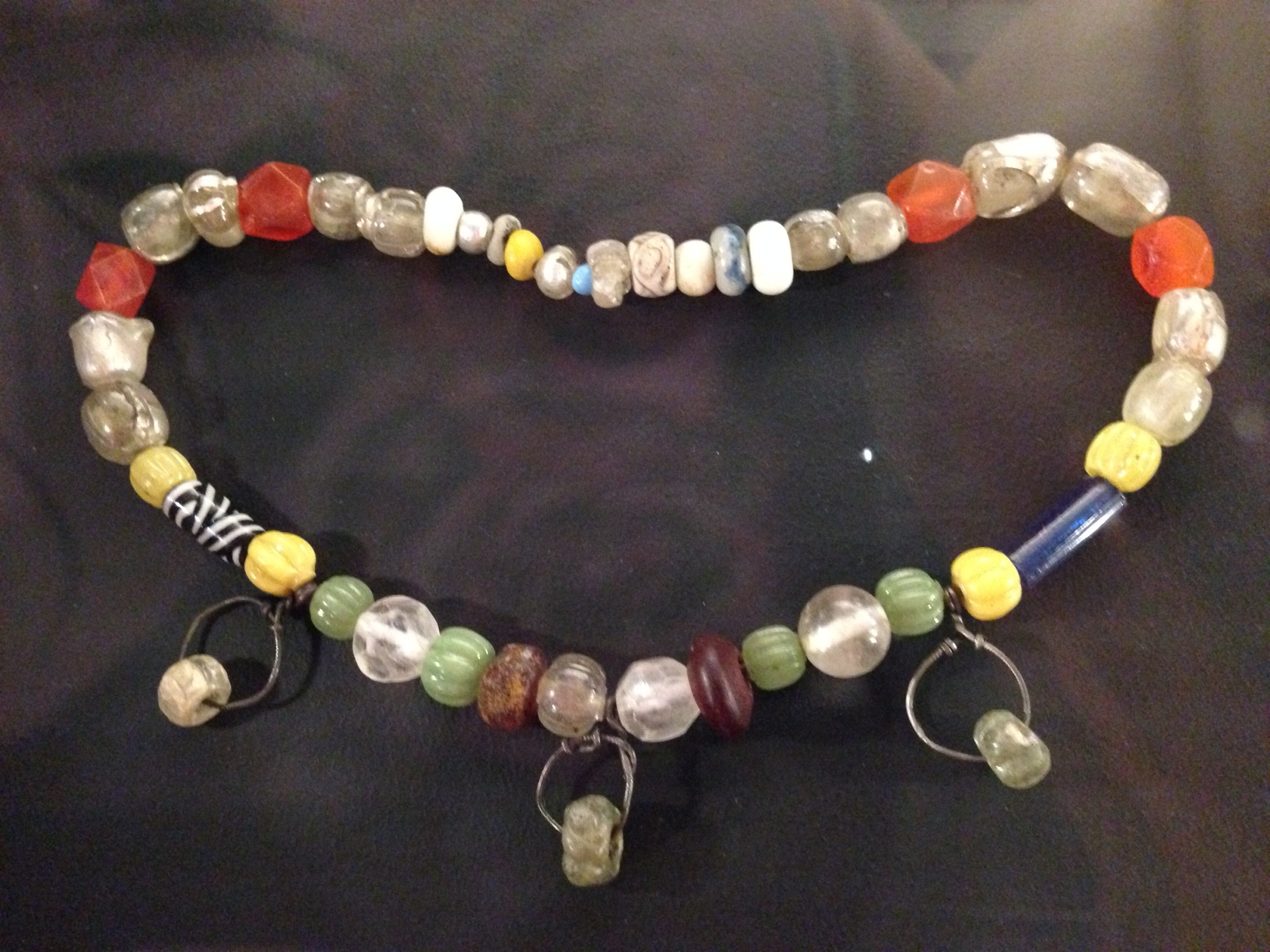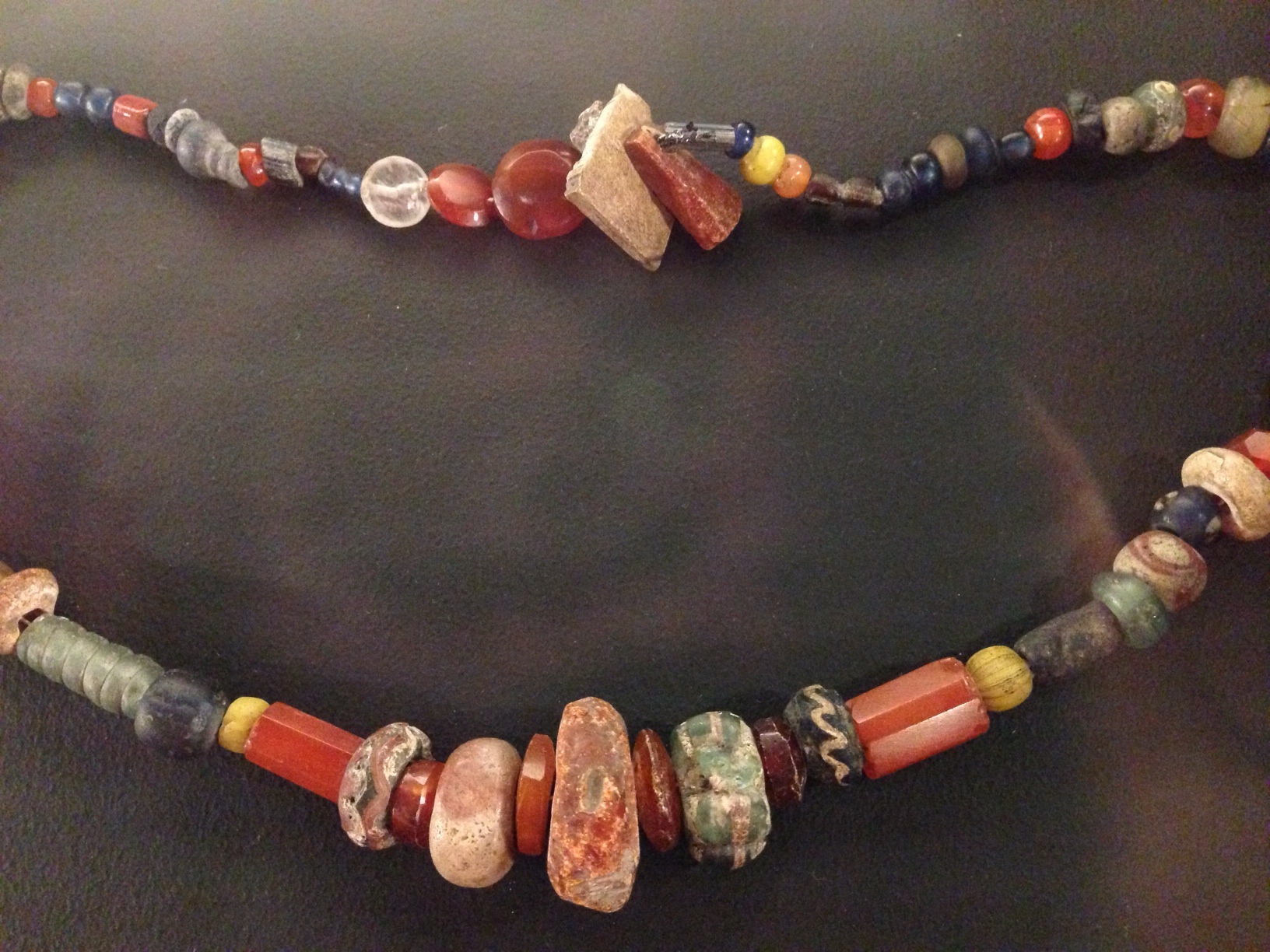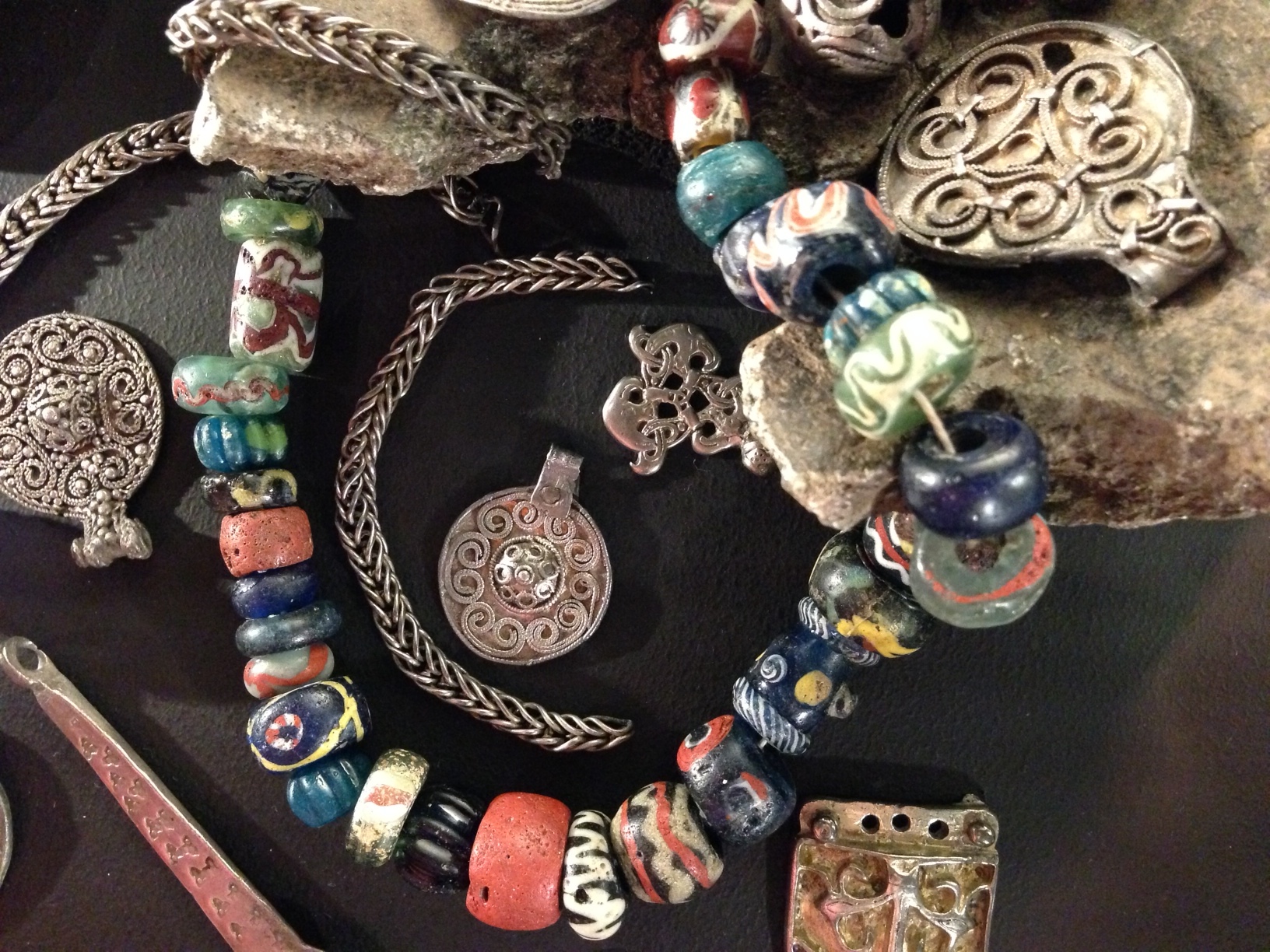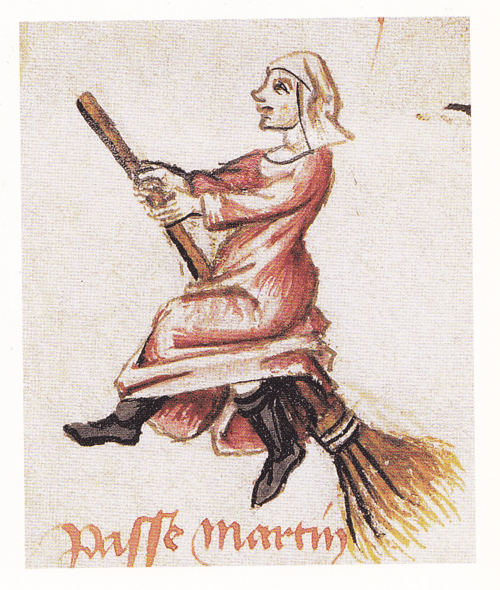Tag Archives: sca
Vikings Exhibition at Australian Maritime Museum
Took a couple of days in Sydney, ostensibly to go check out the ‘Vikings Beyond the Legend’ exhibition currently being hosted at the Australian Maritime Museum, but happily also to catch up with a handful of friends whom I didn’t even know were in Sydney for these days! Fortuitous turn of events, indeed.
Anyway, the Viking exhibition. I was very much looking forward to it as my knowledge of viking history is somewhat rudimentary and I was hoping this would prove an opportunity to, you know… learn some ‘stuff’. The artefacts on display were amazing… there were some remarkably well preserved items showing a wide range of decorative arts from throughout the period, from jewellery (broaches, necklaces, bangles, beads, etc.,) to swords, daggers, shield bosses, combs, and other domestic items of anter and bone.
However, I was really disappointed with the information labelling each item. Objects were listed by their type, material, geographical location and NO indicators of what time frame they came from. Bizarre. I really don’t know what the curatorial team were thinking… apparently the entire exhibit came ‘as is’ from Sweden, having been designed, staged, labelled and presented as you see it everywhere it goes. So they have given each item a blurb that reads what the item is, what the item is made from, and where the item is found, but no information on what period the item originates from?! Seems, the introduction info stating that the Norsemen viking era ranged from the 8th -11th centuries is sufficient for most punters. So if you’re a history student, a bit of a research buff or a re-enactor who might want more information… you’ll kind of have to treat this exhibit like Wikipedia – a jumping off point to go exploring for more information on your own time.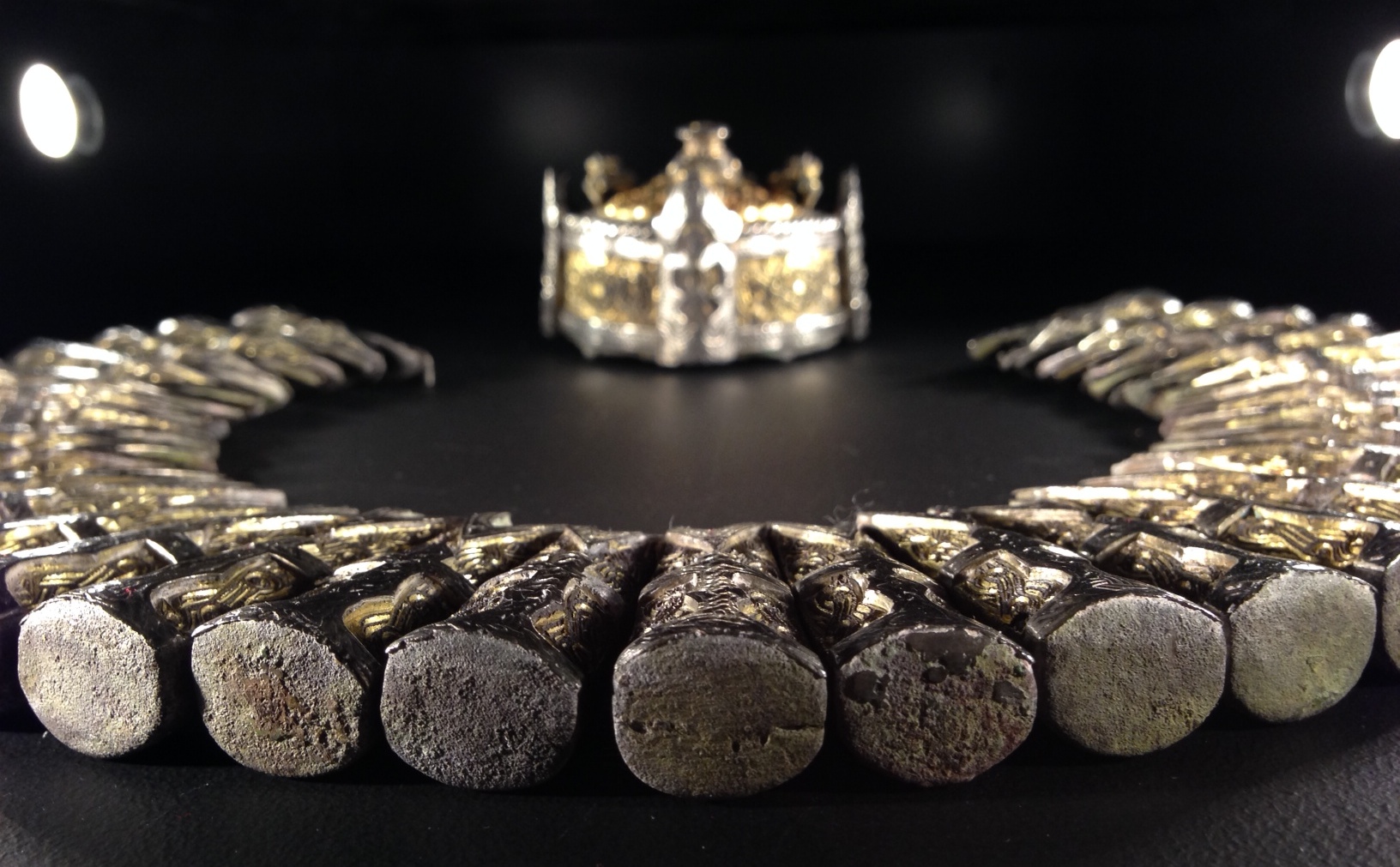

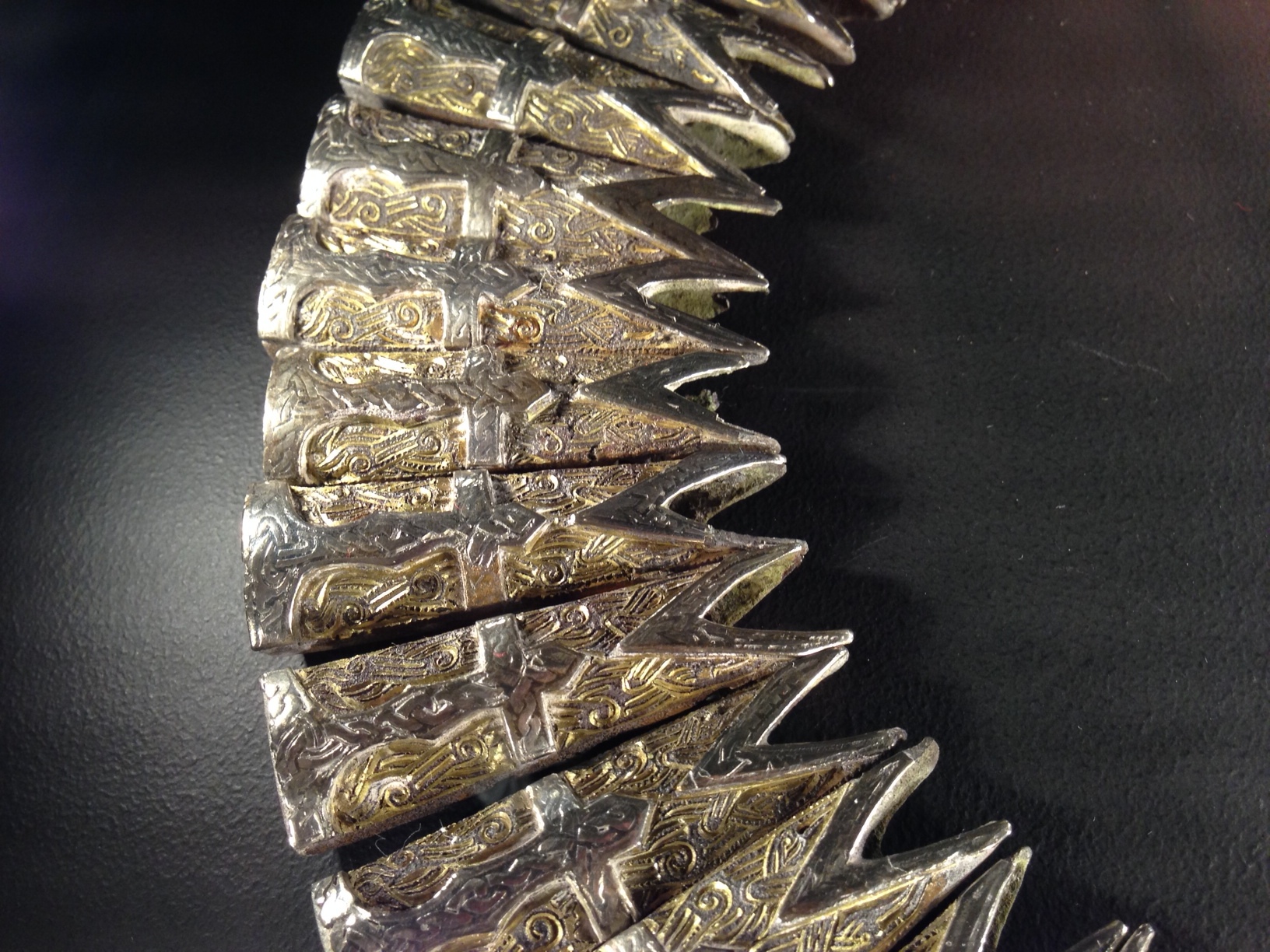
The other weird thing I found odd about the exhibit (and I don’t want to sound like I did not enjoy it – because I did, the items were simply beautiful), was that they didn’t seem to know who their audience was. Several items were there very much designed to attract the attention of children – display on Norse mythology and viking boat building, for example were very much designed for school aged children with interactive computer touchscreens spoon feeding the kids with some history and culture. But then other displays had information written on backlit horizontal surfaces at waist height behind an artefact that anyone less than 5′ tall wouldn’t have a hope in hell of trying to read. Many of the information panels were at coffee table height, again aimed at kids, which meant you walked through the whole thing looking down, and other items were arranged in a free form manner – no obvious or direct ‘flow of traffic’ which visitors could follow to ensure they saw all the items on display. Whole thing felt like the curatorial staff were trying to hard to do something different and basically threw out all the tried and true exhibition practices that had stood the test of time. Bit annoying.
 These two images were taken from Överhogdal tapestries, (no portion of the actual Överhogdal tapestries were accompanying this particular exhibit – the images were included to demonstrate the richness and vividness of Norse textiles and decorative arts), and they depict the destruction of Ragnarök, effectively the Norse version of the apocalypse. I snapped some pics of them as they may provide interesting designs that could be adapted for embroidery projects down the track.
These two images were taken from Överhogdal tapestries, (no portion of the actual Överhogdal tapestries were accompanying this particular exhibit – the images were included to demonstrate the richness and vividness of Norse textiles and decorative arts), and they depict the destruction of Ragnarök, effectively the Norse version of the apocalypse. I snapped some pics of them as they may provide interesting designs that could be adapted for embroidery projects down the track.
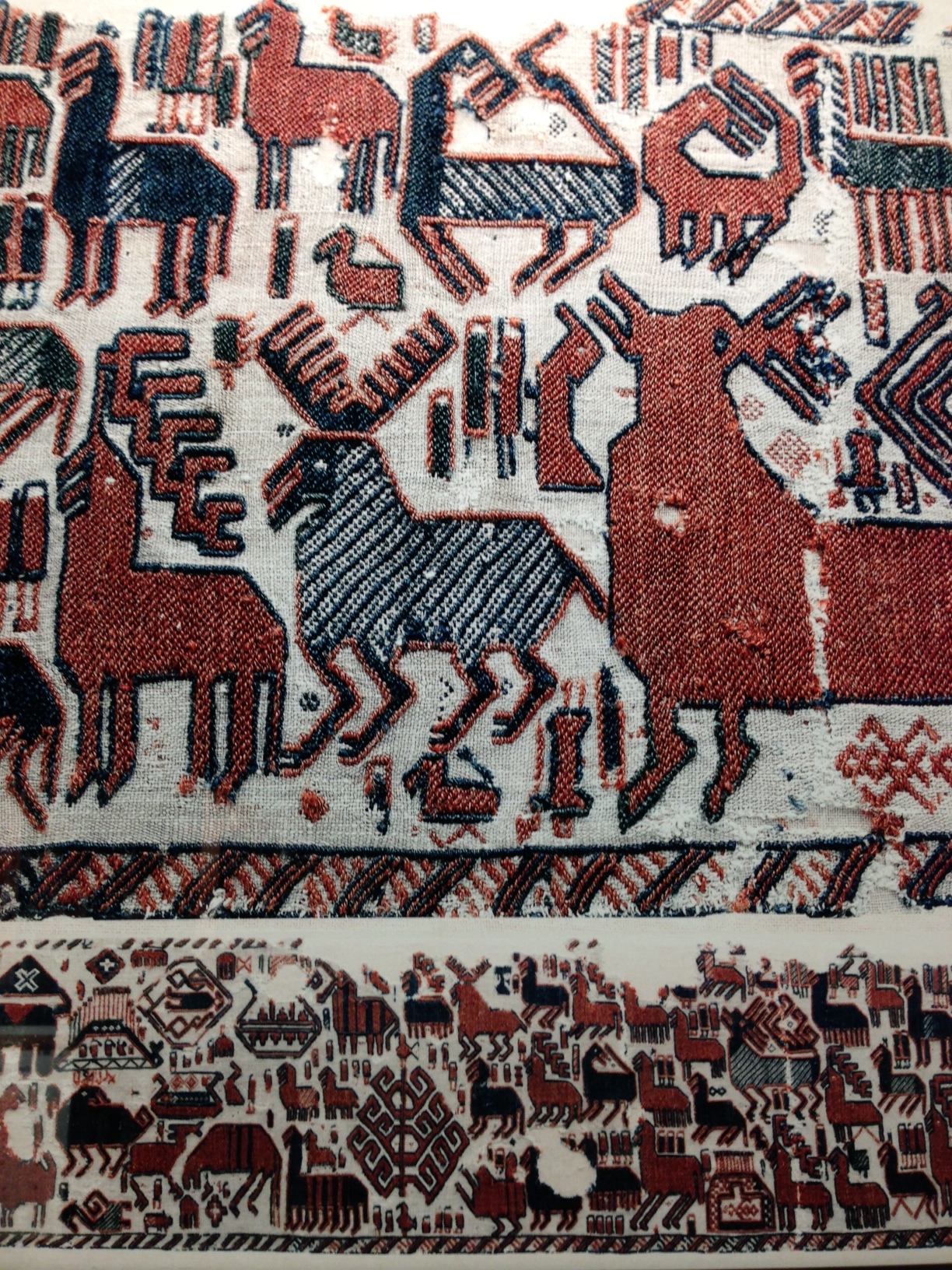
 I was really hoping there would be plenty of information about the viking propensity for beads. I have bought myself some tortoise broaches at Pennsic War earlier this year and have been wanting to start collecting some beads to go with them – but literally didn’t know where to start, so was glad to see that there were so many sets of beads on display at this exhibition. It think these collections give a good feel for the types of beads that Norse women have have worn. However, once again the weird arse exhibition practices have deserted us, and the labels on the various strings of beads came with no information regarding the possible wealth or rank of their potential owners, nor any indication of the time frames they most likely derived from… So, they could have been daily wear for the middle class or ceremonial wear for the aristocracy, and somewhere from the 8thC to 11thC or anywhere in between. More research required.
I was really hoping there would be plenty of information about the viking propensity for beads. I have bought myself some tortoise broaches at Pennsic War earlier this year and have been wanting to start collecting some beads to go with them – but literally didn’t know where to start, so was glad to see that there were so many sets of beads on display at this exhibition. It think these collections give a good feel for the types of beads that Norse women have have worn. However, once again the weird arse exhibition practices have deserted us, and the labels on the various strings of beads came with no information regarding the possible wealth or rank of their potential owners, nor any indication of the time frames they most likely derived from… So, they could have been daily wear for the middle class or ceremonial wear for the aristocracy, and somewhere from the 8thC to 11thC or anywhere in between. More research required.
The broaches they had on display were pretty amazing. There were several sets of tortoise broaches, animal head broaches and these enormous box broaches. They must have weighed a tonne, I can’t imagine wearing them … they were about 3″ across, 1′ high and made of solid iron or bronze. I imagine hanging those of the front of your garment would not have been kind to the bustline over time, especially when age and gravity are already not exactly your friends in that department.

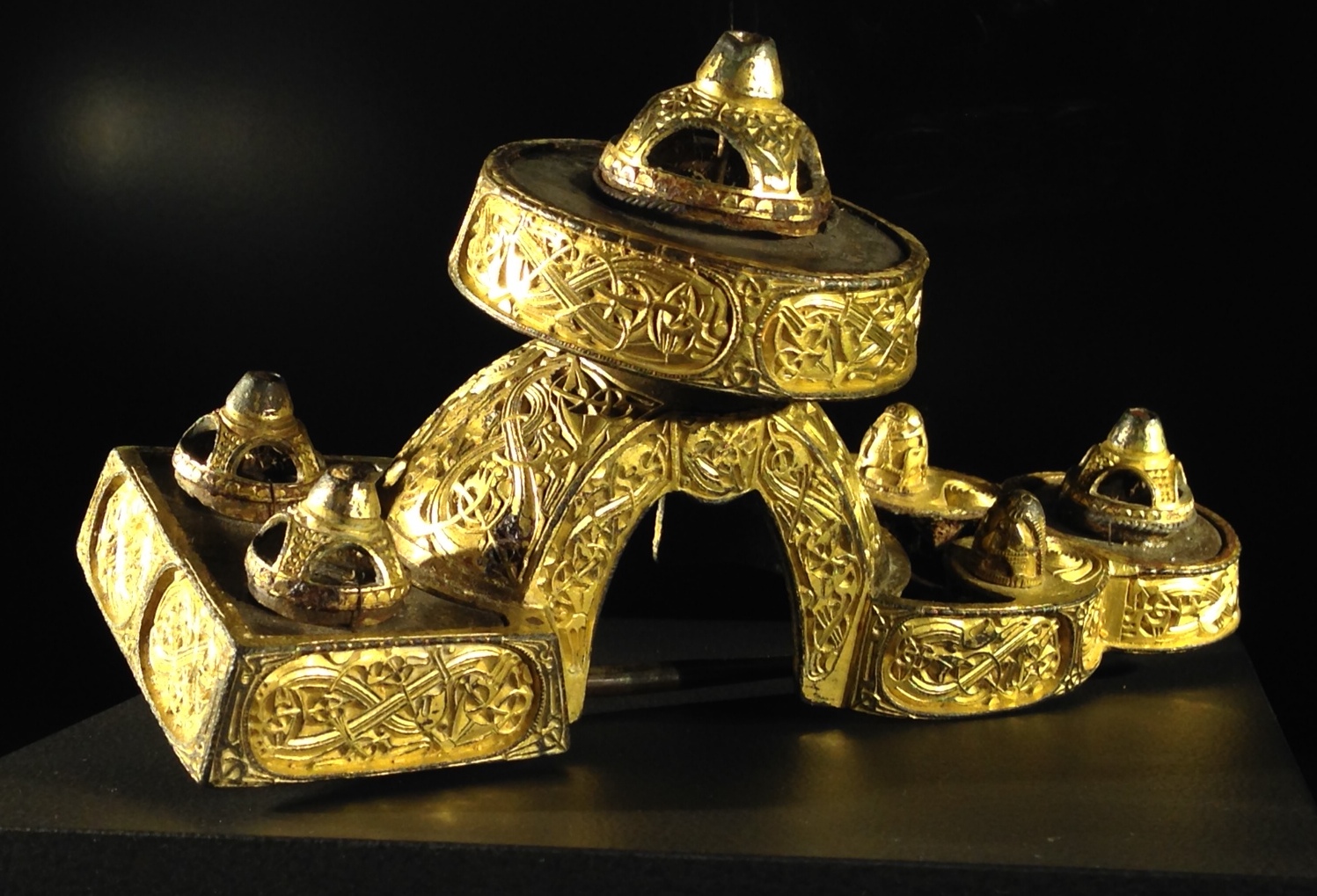 This thing (above) is a broach and button and looking at it on the screen right now – it’s showing up about actual size. Again, one helluva chunky bit of bling to be wearing about. Might have been nice to have some of the weights of these actual items listed in with the descriptions, but seeing that they weren’t even accompanied by estimated time periods, sigh… further information like the weight of the item is just wishful thinking.
This thing (above) is a broach and button and looking at it on the screen right now – it’s showing up about actual size. Again, one helluva chunky bit of bling to be wearing about. Might have been nice to have some of the weights of these actual items listed in with the descriptions, but seeing that they weren’t even accompanied by estimated time periods, sigh… further information like the weight of the item is just wishful thinking. This gorgeous little cup is about the size of a modern shot glass. It has a Jellinge style zoomorphic design engraved/carved into it and was stunningly well preserved for something that is potentially 800-1200 years old (so vague!). I wish I had been able to get closer to it (or that there was decent photos of it in the catalogue) as I think I’d like to have a go at making one of these.
This gorgeous little cup is about the size of a modern shot glass. It has a Jellinge style zoomorphic design engraved/carved into it and was stunningly well preserved for something that is potentially 800-1200 years old (so vague!). I wish I had been able to get closer to it (or that there was decent photos of it in the catalogue) as I think I’d like to have a go at making one of these.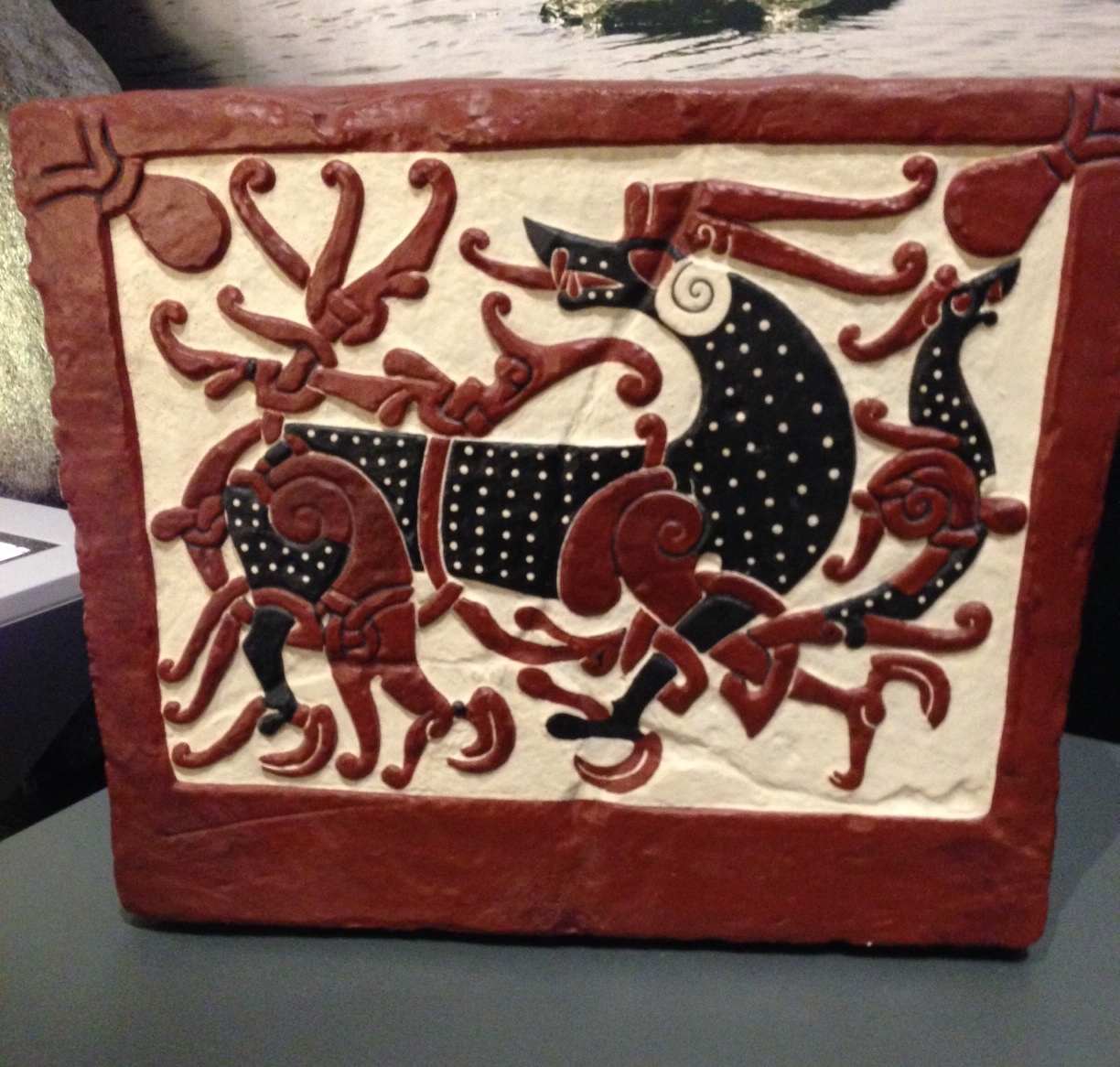

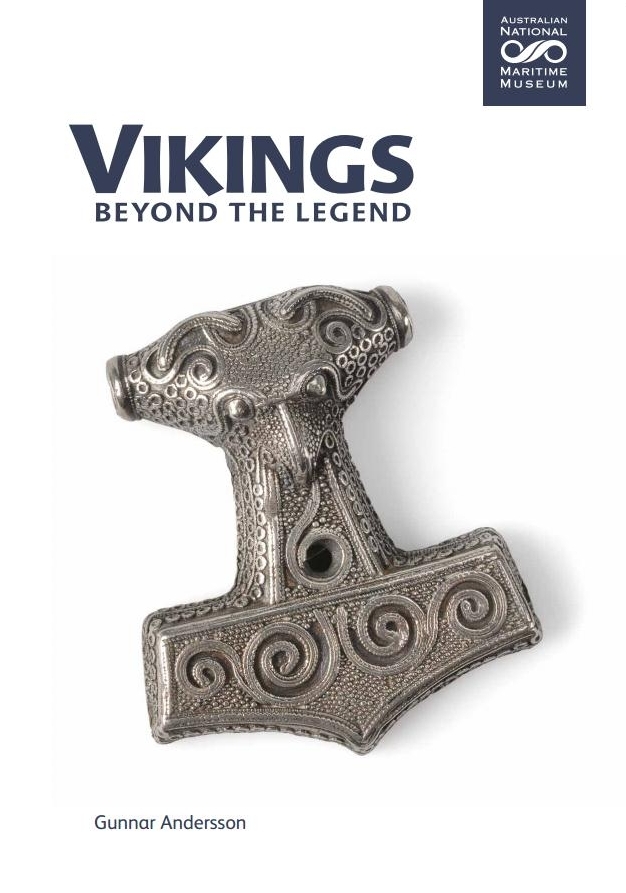 By the time we got to the end of the exhibit I was desperately wanting to see the catalogue to discover if that be where all the missing information that I desperately wanted to see, was lurking. But, no such luck.
By the time we got to the end of the exhibit I was desperately wanting to see the catalogue to discover if that be where all the missing information that I desperately wanted to see, was lurking. But, no such luck.
The Director of the exhibition, Gunnar Andersson, was also the editor/author of the catalogue and yet again, actual dates of the artefacts were deemed not necessary! The photography in the catalogue was a bit ho-hum… so, I didn’t end up buying a copy, which is a bit unusual for me. Ordinarily exhibition catalogues are the ducks nuts – full of tidbits of information that are hard to come by on the internet or only found by digging around in wordy and boring journal articles. But not so much on this occasion!
All up I am glad I took the trouble to see the exhibition, and given it is not coming to BrisVegas, the trip to Sydney was well worth it* – some of the items on display were simply magnificent to view firsthand. However, I was rather disappointed that the curatorial ‘vision’ for the exhibition, felt like it was trying just a little too hard to be different and didn’t seem to be appropriately aimed at any particular audience – bit too grown up for the kids; yet lacking in suitable referencing for serious scholars.
*not to mention the unexpected bonus Ansell Adams exhibition
that was also on at the Maritime Museum while we were there.
Oh fair trailer, why didst thou forsake us?
Getting of to Rowany Festival each year is a lot of hard work, and that is if everything runs smoothly. But there is so much potential for something trip to go pear shaped that over the years you expect at least one thing won’t go to plan. Normally it’ll be ridiculous amounts of road works that slow down your trip causing you to arrive and be setting up in the dark. Or it will be a ‘eek, no Vacancies in Tarree’ moment and you end up driving right through the night and arriving on site at sparrow’s without having slept at all. Or you’ll rock up on site and discover your tent is all there except for your fly and suddenly you’re trying to cadge a space in someone else’s tent! So you hope that the road trip bit isn’t going to be too traumatic… but kinda half plan for something to go awry.
This year, the cluster started before we even left town. All packed up, a tonne of stuff to take down and thankfully only half of it was coming back. Due to the huge amount of stuff we were taking (including but not limited to, 3 tents, poles and pegs, stonking huge solid jarrah medieval bed, hot water system, gas bottles, tables, chairs, stretchers, mattresses, sleeping gear, garb and I know not what!) we borrowed a trailer from some friends Mr&Mrs ColdSnail.
We get it all sorted and well packed – GraGra would have been proud at the weight distribution and Tetris-like way it all packed together – and hitch it to the car and get ready to hit the road. Only we then discover that the trailer lights don’t work! Bugger. Is it the car? The trailer? Or the seven straight to seven round adaptor causing the problem? Go to have a look at the adaptor and it literally falls apart in Yale’s hand. Not good. Off to Super Cheap to buy a new adaptor… $40 thanks for coming. Take it back, plug it in and still no joy. Car fuses are all good, cords in good nick… unscrew the lights and disco! Wires are all corroded and ain’t no way them thar trailer lights are going to work. Probably could get away with it if you’re planning on a trip around the corner to the tip, but not so much for the nearly 2000km round trip to Festival and back on one of the busies weekends of the year!
Switch to Plan B! Try the external trailer lights we had put on GraGra’s old trailer the previous year and attach them to the borrowed trailer. But of course, since that trailer was used a while ago to move furntiture and stuff, it’s been sitting outside and these temporary light boards aren’t designed to withstand the elements permanently so it too was sufferering from corrosion! Off to Super Cheap to buy another external trailer light board… $104 thanks for coming. Take it back and hook it directly to car and finally we have lift off!
Yale gets on the road nearly three hours later and $150 lighter than planned 🙁 Yeah. That bit isn’t so great. Things seemed to be going okay, other than the aforementioned and anticipated road works on the Pacific Highway slowing things down from time to time until… blown out trailer tyre at 100kmph just north of Taree. Absolutely shredded. Thankfully Yale is ‘car people’ and has the right tools, nouse and skills to 1) not careen off the road 2) change the tyre without too much ill effect and 3) get going again in short time. Find a place to get the tyre replaced and drop it off with a promise of picking it up tomorrow. Find somewhere to stay in Taree.
Come back the next afternoon to collect the tyre only to be told, ‘we didn’t get to it, sorry mate, come back after the holidays’. Head off for the rest of the journey without a spare and keep fingers crossed. Spend the weekend off Medievalling in a paddock – set up, dress up, go to court, shop a bit, drink a lot, pack down, and head off again! And that’s the quickest version of that event you’ll ever hear!
Drive back to collect tyre, thankfully all fixed… $90 thanks for coming. And head back to Bris Vegas for a long but thankfully uneventful trip!
TIL… lots of cool stuff.
Today I learned that that even though we think we are living in an enlightened age of reason, science and technology, there are so many element intrinsic to Western thinking that might as well be purely Medieval. For example, attitudes towards rape and rape victims really havent changed that much over the last 500 years. In Renaissance Italy, the bulk of rape incidents happen by a known perpetrator and often in the victims own home, and usually went unreported as the shame and stain on a woman’s character was detrimental to her future. Women were still frequently considered to have ‘asked for it’, if she has allowed her person to be alone, unguarded, unprotected (fryndlesse) or dressed provocatively. Many rapists felt they have done nothing wrong and are therefore not repentent about their crimes, this was particularly evident in the case in group or gang rapes where the male agressor/s gain acceptance and reinforcement of their overt masculinities from their cohorts. Women of lower/servant classes or disenfranchised minorities were often at very high risk of sexual assault due to the protection afforded to their ‘betters’ or more monied counterparts… any of this sounding familiar? Yep, many of these aspects of rape mentality haven’t gone very far at all, particularly in some of our modern global cultures.
I also learned that eating disorders and anorexia tended to affect the same demographic of young woman in Puritan England that it does now… young women from well to do backgrounds, often with very religious backgrounds whose primarily emotional disturbance is doubt – primarily self doubt. In Puritan England it was their burgeoning sexuality and the subsequent conflict with their piety that caused that self doubt and following self loathing. Prescriptions for such melancholias included fasting… but many young women took the fasting treatment as seriously as they took their religion and then endured long term battles with willing periods of not nourishing their ‘traitorous bodies’ that were full of lust and potential for sin. Modern day women (in the US at any rate, stats for Australia not available due to overzealousness of political correctness) are from the same demographics – tend to be from middle to upper class families with heavy religious backgrounds and similar expectations. Confusion arises in young teens when puberty, adolescent angst and sexual experimentation leads to self and body perception issues. Similar results ensue for many sufferers… years of fighting with a very serious condition that results from emotional dissatisfaction and disconnection from one’s own body.
Today I learned that post-partum depression, while much more widely acknowledge and recognizable in modern society, was just as present in Medieval life as it is today. Perhaps even more so as women had so many children. Margery Kempe was literally driven mad after the birth of her first child and in the absence of medical or psychological treatment turned to friends, family and townspeople for support. Eventually she turned to Christ for salvation and claimed it was only His divine intervention and her continued desire to please Christ that kept her from relapsing through the birth of her next 13 children. But she ended up mad as pants in the end anyway according to her neighbours – which is by way of saying, she became one of those ‘uppity’ women of the Middle Ages who refused to be controlled by the social constraints of the time. And after 14 kids, I think she deserves to be as free and uncontrolled as she wants to be!
I also learned that witches had consensual and emotionally fulfilling, sometimes long term, sexual relations with devils and demons that visited them in the night to ‘suckle at their genitalia’! That presumed witches don’t float for a reason (but that’s a much longer story for another time) and that witch-hunting was a systematised and very lucrative business. 🙂
This conferences has been so full of amazing papers, wonderful people and interesting facts that I can’t wait for the next one – which is at the University of Queensland in 2015.
The Uses of Violence…
- Rape and Ritual in Renaussance Italy: The Normalization of Violence?
- “What shee hath often seene”: Family Violence in Pre-Modern Ireland
Witchcraft in Translation…
- The Witch-Finder General: The Matthew Hopkins Pamphlett.
- Sleeping With Devils: The Sexual Witch in the Seventeenth Century England.
- Glanvill in Germany: Translating an English Debate on Witchcraft and Spirits.
Medieval and Early Modern Echoes in Healthcare…
- Margery Kempe and Postnatal Psychosis: Going ‘owt of hir minde’.
- Vesalius Writing on the Body of Medicine: from translation to Direct Observation.
- Puberty and Eating Disorders in Puritan England.
Qualities of Kings: The Representation of Medieval English Monarchs…
- The Portrait of Henry the Young King in the History of William Marshall.
- How to Construct a King: The Correspondence of Edward I and Llwelyn ap Gruffydd
- ‘Sodenly he was changed into a new man’: The Self-fashioned Masculinity of Henry V
If I’m ever in trouble, I want this guy to defend me.
The ANZAMEMS conference has been awesome. I have attended some fantastic papers on lots of interesting topics. It turns out that we are not going to be getting access to the conference papers at the end and they’re not being published anywhere… which is a bit disappointing given it’s impossible to get to all the sessions. I imagine the big conferences like Leeds would be even worse for trying to picking and choosing which panels to attend. Oh well, thems the breaks. I went to panels on –
Thinking Through Animals
- Robert Henryson’s fabulous ‘Maner of translatioun”: ‘perfite studie” getting “science”.
- Anthropomorphism: Animal versus Human Nature in William Baldwin’s ‘Beware the Cat’ and William Caxton’s ‘The History of Reynard the Fox’
- Prosecuting Animals as Criminals in Late Medieval Europe*
Heresy, Witchcraft and Deviance
- The Cultural Work of Witchcraft – Salem 1692
- The Cultural Translation of Demonic Possession from England to Bermuda: “A True Narrative of the Grevious Afflicition of Roger Sterrop in Somer Islands”
- “Arnalda de la Motta: The Ministry of a Female Perfect
Gendered Practices
- Til Death Do Us Part – Practice of Divorce during the Merovingian period.
- English Cistercian Nuns and their Interactions with Cistercian Commissioners and the Cistercian General Chapter in the 15th-16th Centuries.
- Grandmothers and Granddaughters: Four Generations of Medici Women at the Grand Ducal Court
I learned lots of cool stuff yesterday including but not limited to the fact that the Christian Church during the Merovingian period would absolutely not tolerate bigamous relations in amy form amongst royal families at the time, however incestuous ones, so long as they were formed before the Church knew anything about them were pretty much in the clear.
The Eleanora of Aragon was a lot tougher and smarter chicky then I knew her to be and she really doesn’t get enough credit for running the entire kingdom while her husband was off gallivanting about at war. Same of the Medici broads, generations of them effected royal houses for centuries and they ranged from being the most forebearing and hard done by, to being powerfully manipulative and sympathy worthy political pawns!
*The most interesting talk I heard though was on ‘Prosecuting Animals as Criminals in Late Medieval Europe. In 1522, in Autun France, the local townspeople sued the town’s rats for having eaten and created great damage to the town’s granaries. The rats were duly given a lawyer, one Bartolome Chaussime (who would later become the Chief Justice of the Supreme Cout in Provence) and the trial was conducted exactly like any other. The day of trail arrives and unfortunately the Defendants failed to appear in court. Chaussime, clever lawyer that he is, claimed his clients refused to attend court due to the prejudicial language in the summons which called them ‘dirty, grey, scoundrelous thieves’. The judge was forced to agree and held the trial date over saying the Claimants would have to moderate the language in the summons in order to reflect the not yet proven guilty status of the Defendants… and a new trial date was set.
On the next trial date, there was once again, a notable absence of Defendants in the courtroom. At this point the townspeople were outraged, but the lawyer for the Defence calmly stated that his clients were confused, that the writ of summons was too vague that among themselves, they did not know which of them needed to appear in court, that they thought others of their community would be in attendance and that the net result is that none attended! The judge agreed and instructed the Claimants to be more specific in identifying their wrong-doers so that a proper summons might be drafted and a new court date set.
The next court date duly arrived (you can really tell the court appointed lawyer is being paid by the hour!) and still there was no Defendants. On this occasion Chaussime argued that his clients being largely illiterate had not been able to read if the summons applied to them as individual rats of the town of Autun and therefore had not been able to understand if they were required. The judge, in his wisdom, agreed that this of course was a conundrum and decreed that the summons should be read from every pulpit in every church throughout the town for two weeks before the next court date could be set. Thus the trial was further delayed.
Finally, yet another court date occurred, and by now it was turning into quite the public spectacle. And yet, on this occasion, again the Defendants failed to appear! Their clever lawyer however said that his Clients, the rats, could not appear in court due to fear for their lives from the cats belonging to the good townspeople of Autun, and it was fear of capture and/or persecution that kept the rats from attending the court. At which time also, the clever Chaussime applied to the court for a guaranteed right of safe passage and a protection order to enable the rats to attend court – this would involve the townspeople restraining, binding or otherwise keeping in their cats for the duration.
Well, this the townspeople thought was ridiculous! (LOL) And they flatly refused to bind their cats in order that the rats might be able to attend court and rightly be brought to justice for their heinous crimes committed in the granary and against the townspeople of Autun… therefore the judge was forced to dismiss the case!
The whole thing is so exquisitely absurd that you couldn’t make it up if you tried. There were also lots of other examples of animal trials in the Medieval period, including a tragic and slightly alarming story about a sow. But there have been awesome little gems of information in every presentation like this… so I am having a ball! If I can find the time I am considering doing some research into animal trials myself and may perhaps do a research collegium at Festival if people are interested. 🙂
Roman d’Alexandre, Tournai, 1338-1344. (Bodleian Library, MS. Bodl. 264, fol. 94v)
Couldn’t find a manuscript image of rats in the granary on short notice, so I’ve given you monkeys into the wine instead! 🙂





